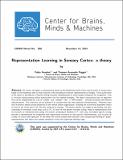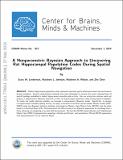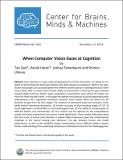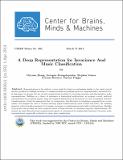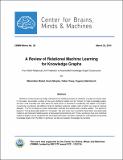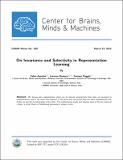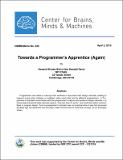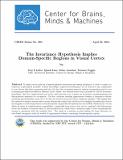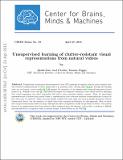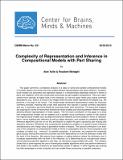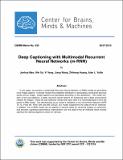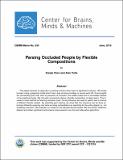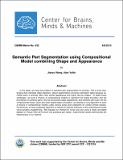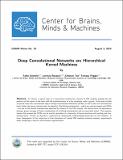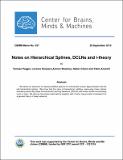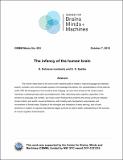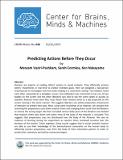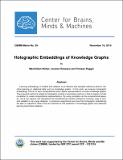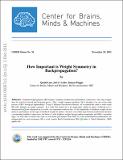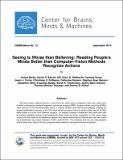Browsing CBMM Memo Series by Issue Date
Now showing items 21-40 of 141
-
Representation Learning in Sensory Cortex: a theory
(Center for Brains, Minds and Machines (CBMM), 2014-11-14)We review and apply a computational theory of the feedforward path of the ventral stream in visual cortex based on the hypothesis that its main function is the encoding of invariant representations of images. A key ... -
A Nonparametric Bayesian Approach to Uncovering Rat Hippocampal Population Codes During Spatial Navigation
(Center for Brains, Minds and Machines (CBMM), arXiv, 2014-12-01)Rodent hippocampal population codes represent important spatial information about the environment during navigation. Several computational methods have been developed to uncover the neural representation of spatial topology ... -
When Computer Vision Gazes at Cognition
(Center for Brains, Minds and Machines (CBMM), arXiv, 2014-12-12)Joint attention is a core, early-developing form of social interaction. It is based on our ability to discriminate the third party objects that other people are looking at. While it has been shown that people can accurately ... -
A Deep Representation for Invariance And Music Classification
(Center for Brains, Minds and Machines (CBMM), arXiv, 2014-17-03)Representations in the auditory cortex might be based on mechanisms similar to the visual ventral stream; modules for building invariance to transformations and multiple layers for compositionality and selectivity. In this ... -
A Review of Relational Machine Learning for Knowledge Graphs
(Center for Brains, Minds and Machines (CBMM), arXiv, 2015-03-23)Relational machine learning studies methods for the statistical analysis of relational, or graph-structured, data. In this paper, we provide a review of how such statistical models can be “trained” on large knowledge graphs, ... -
On Invariance and Selectivity in Representation Learning
(Center for Brains, Minds and Machines (CBMM), arXiv, 2015-03-23)We discuss data representation which can be learned automatically from data, are invariant to transformations, and at the same time selective, in the sense that two points have the same representation only if they are one ... -
Towards a Programmer’s Apprentice (Again)
(Center for Brains, Minds and Machines (CBMM), 2015-04-03)Programmers are loathe to interrupt their workflow to document their design rationale, leading to frequent errors when software is modified—often much later and by different programmers. A Pro- grammer’s Assistant could ... -
The Invariance Hypothesis Implies Domain-Specific Regions in Visual Cortex
(Center for Brains, Minds and Machines (CBMM), bioRxiv, 2015-04-26)Is visual cortex made up of general-purpose information processing machinery, or does it consist of a collection of specialized modules? If prior knowledge, acquired from learning a set of objects is only transferable to ... -
Unsupervised learning of clutter-resistant visual representations from natural videos
(Center for Brains, Minds and Machines (CBMM), arXiv, 2015-04-27)Populations of neurons in inferotemporal cortex (IT) maintain an explicit code for object identity that also tolerates transformations of object appearance e.g., position, scale, viewing angle [1, 2, 3]. Though the learning ... -
Complexity of Representation and Inference in Compositional Models with Part Sharing
(Center for Brains, Minds and Machines (CBMM), arXiv, 2015-05-05)This paper performs a complexity analysis of a class of serial and parallel compositional models of multiple objects and shows that they enable efficient representation and rapid inference. Compositional models are generative ... -
Deep Captioning with Multimodal Recurrent Neural Networks (m-RNN)
(Center for Brains, Minds and Machines (CBMM), arXiv, 2015-05-07)In this paper, we present a multimodal Recurrent Neural Network (m-RNN) model for generating novel image captions. It directly models the probability distribution of generating a word given previous words and an image. ... -
Parsing Occluded People by Flexible Compositions
(Center for Brains, Minds and Machines (CBMM), arXiv, 2015-06-01)This paper presents an approach to parsing humans when there is significant occlusion. We model humans using a graphical model which has a tree structure building on recent work [32, 6] and exploit the connectivity prior ... -
Semantic Part Segmentation using Compositional Model combining Shape and Appearance
(Center for Brains, Minds and Machines (CBMM), arXiv, 2015-06-08)In this paper, we study the problem of semantic part segmentation for animals. This is more challenging than standard object detection, object segmentation and pose estimation tasks because semantic parts of animals often ... -
Deep Convolutional Networks are Hierarchical Kernel Machines
(Center for Brains, Minds and Machines (CBMM), arXiv, 2015-08-05)We extend i-theory to incorporate not only pooling but also rectifying nonlinearities in an extended HW module (eHW) designed for supervised learning. The two operations roughly correspond to invariance and selectivity, ... -
Notes on Hierarchical Splines, DCLNs and i-theory
(Center for Brains, Minds and Machines (CBMM), 2015-09-29)We define an extension of classical additive splines for multivariate function approximation that we call hierarchical splines. We show that the case of hierarchical, additive, piece-wise linear splines includes present-day ... -
The infancy of the human brain
(Center for Brains, Minds and Machines (CBMM), Neuron, 2015-10-07)The human infant brain is the only known machine able to master a natural language and develop explicit, symbolic, and communicable systems of knowledge that deliver rich representations of the external world. With the ... -
Predicting Actions Before They Occur
(Center for Brains, Minds and Machines (CBMM), 2015-10-26)Humans are experts at reading others’ actions in social contexts. They efficiently process others’ movements in real-time to predict intended goals. Here we designed a two-person reaching task to investigate real-time body ... -
Holographic Embeddings of Knowledge Graphs
(Center for Brains, Minds and Machines (CBMM), arXiv, 2015-11-16)Learning embeddings of entities and relations is an efficient and versatile method to perform machine learning on relational data such as knowledge graphs. In this work, we propose holographic embeddings (HolE) to learn ... -
How Important is Weight Symmetry in Backpropagation?
(Center for Brains, Minds and Machines (CBMM), arXiv, 2015-11-29)Gradient backpropagation (BP) requires symmetric feedforward and feedback connections—the same weights must be used for forward and backward passes. This “weight transport problem” [1] is thought to be one of the main ... -
Seeing is Worse than Believing: Reading People’s Minds Better than Computer-Vision Methods Recognize Actions
(2015-12-10)We had human subjects perform a one-out-of-six class action recognition task from video stimuli while undergoing functional magnetic resonance imaging (fMRI). Support-vector machines (SVMs) were trained on the recovered ...

